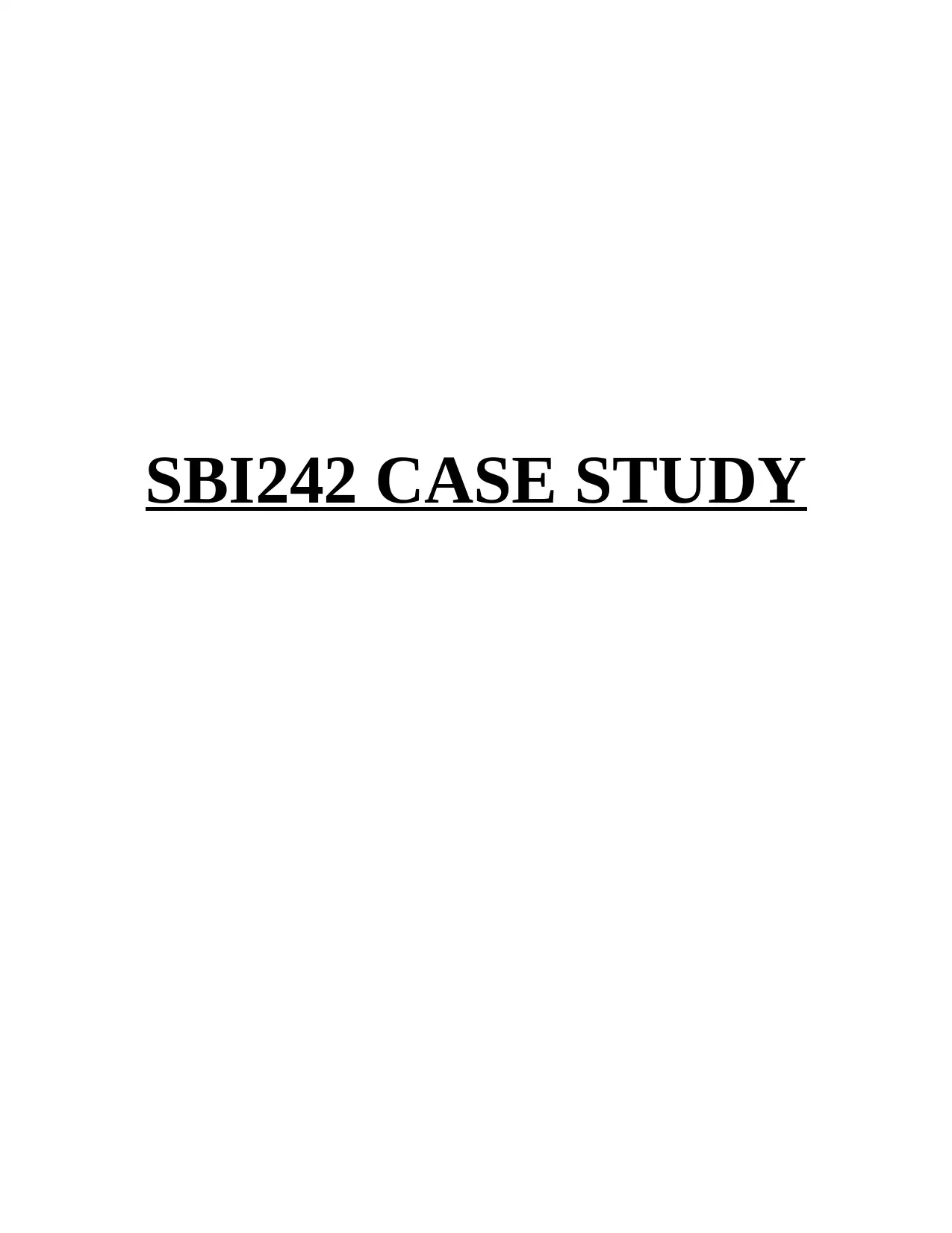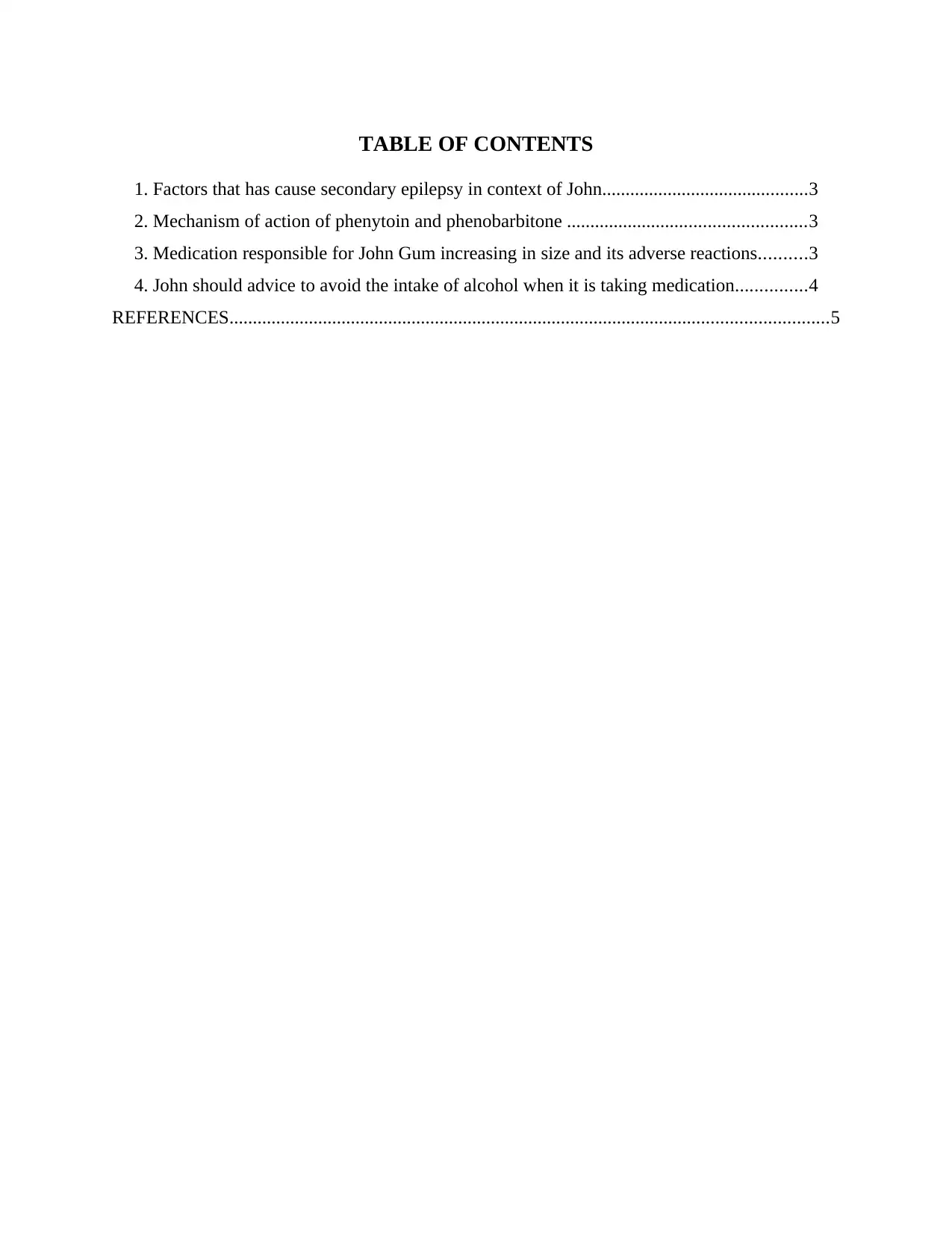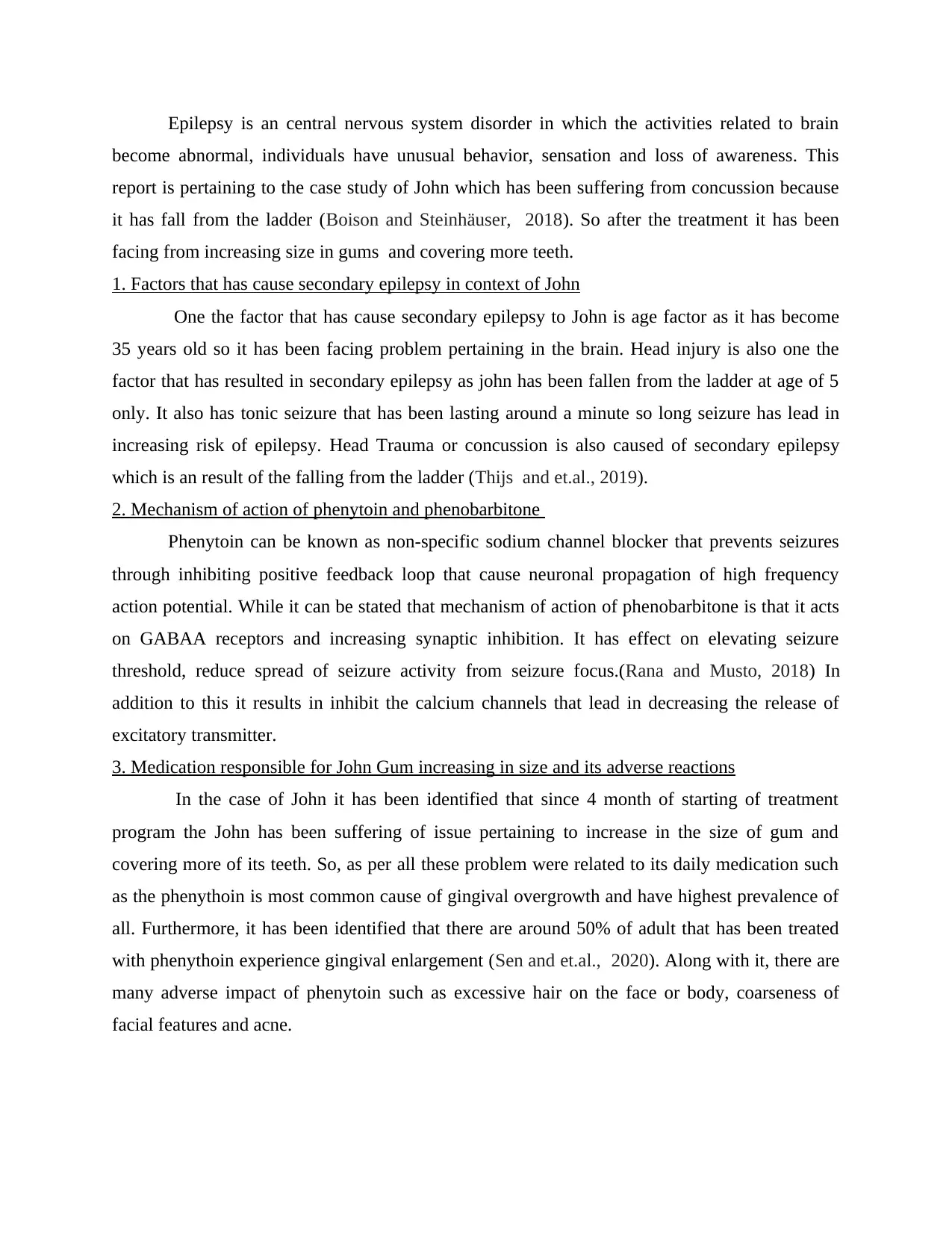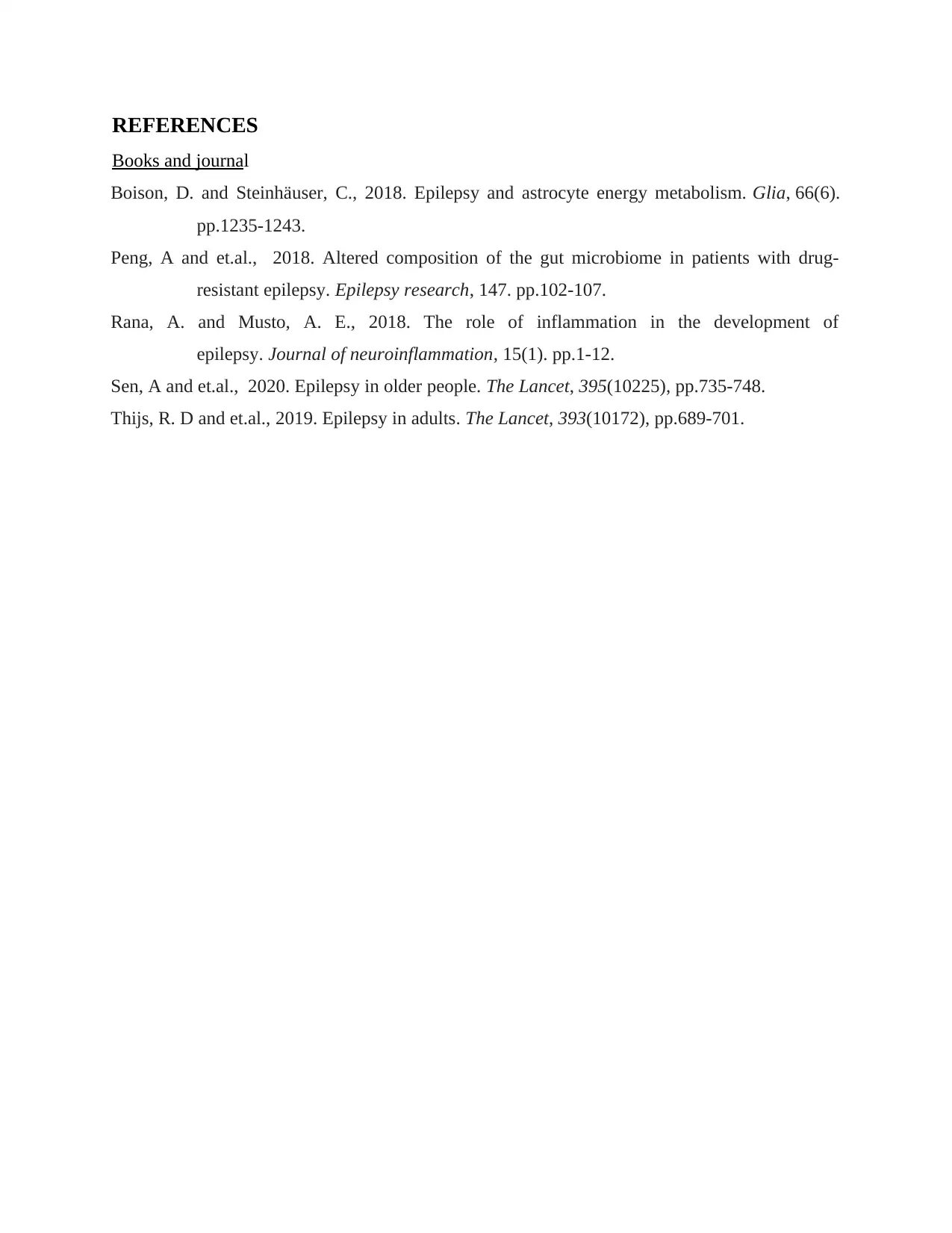SBI242 Case Study: Epilepsy Management, Medication, and Complications
VerifiedAdded on 2023/06/18
|5
|783
|461
Case Study
AI Summary
This case study analyzes the condition of John, a 35-year-old male diagnosed with secondary epilepsy following a concussion. The report identifies factors contributing to his epilepsy, including age and head trauma, and explains the mechanisms of action of phenytoin and phenobarbitone, the prescribed antiepileptic drugs. It further investigates the adverse effects of phenytoin, specifically gingival overgrowth, and advises against alcohol consumption due to its potential to exacerbate side effects and increase seizure risk. The case emphasizes the importance of understanding medication side effects and lifestyle modifications in managing epilepsy effectively. Desklib offers similar solved assignments and past papers for students.

SBI242 CASE STUDY
Paraphrase This Document
Need a fresh take? Get an instant paraphrase of this document with our AI Paraphraser

TABLE OF CONTENTS
1. Factors that has cause secondary epilepsy in context of John............................................3
2. Mechanism of action of phenytoin and phenobarbitone ...................................................3
3. Medication responsible for John Gum increasing in size and its adverse reactions..........3
4. John should advice to avoid the intake of alcohol when it is taking medication...............4
REFERENCES................................................................................................................................5
1. Factors that has cause secondary epilepsy in context of John............................................3
2. Mechanism of action of phenytoin and phenobarbitone ...................................................3
3. Medication responsible for John Gum increasing in size and its adverse reactions..........3
4. John should advice to avoid the intake of alcohol when it is taking medication...............4
REFERENCES................................................................................................................................5

Epilepsy is an central nervous system disorder in which the activities related to brain
become abnormal, individuals have unusual behavior, sensation and loss of awareness. This
report is pertaining to the case study of John which has been suffering from concussion because
it has fall from the ladder (Boison and Steinhäuser, 2018). So after the treatment it has been
facing from increasing size in gums and covering more teeth.
1. Factors that has cause secondary epilepsy in context of John
One the factor that has cause secondary epilepsy to John is age factor as it has become
35 years old so it has been facing problem pertaining in the brain. Head injury is also one the
factor that has resulted in secondary epilepsy as john has been fallen from the ladder at age of 5
only. It also has tonic seizure that has been lasting around a minute so long seizure has lead in
increasing risk of epilepsy. Head Trauma or concussion is also caused of secondary epilepsy
which is an result of the falling from the ladder (Thijs and et.al., 2019).
2. Mechanism of action of phenytoin and phenobarbitone
Phenytoin can be known as non-specific sodium channel blocker that prevents seizures
through inhibiting positive feedback loop that cause neuronal propagation of high frequency
action potential. While it can be stated that mechanism of action of phenobarbitone is that it acts
on GABAA receptors and increasing synaptic inhibition. It has effect on elevating seizure
threshold, reduce spread of seizure activity from seizure focus.(Rana and Musto, 2018) In
addition to this it results in inhibit the calcium channels that lead in decreasing the release of
excitatory transmitter.
3. Medication responsible for John Gum increasing in size and its adverse reactions
In the case of John it has been identified that since 4 month of starting of treatment
program the John has been suffering of issue pertaining to increase in the size of gum and
covering more of its teeth. So, as per all these problem were related to its daily medication such
as the phenythoin is most common cause of gingival overgrowth and have highest prevalence of
all. Furthermore, it has been identified that there are around 50% of adult that has been treated
with phenythoin experience gingival enlargement (Sen and et.al., 2020). Along with it, there are
many adverse impact of phenytoin such as excessive hair on the face or body, coarseness of
facial features and acne.
become abnormal, individuals have unusual behavior, sensation and loss of awareness. This
report is pertaining to the case study of John which has been suffering from concussion because
it has fall from the ladder (Boison and Steinhäuser, 2018). So after the treatment it has been
facing from increasing size in gums and covering more teeth.
1. Factors that has cause secondary epilepsy in context of John
One the factor that has cause secondary epilepsy to John is age factor as it has become
35 years old so it has been facing problem pertaining in the brain. Head injury is also one the
factor that has resulted in secondary epilepsy as john has been fallen from the ladder at age of 5
only. It also has tonic seizure that has been lasting around a minute so long seizure has lead in
increasing risk of epilepsy. Head Trauma or concussion is also caused of secondary epilepsy
which is an result of the falling from the ladder (Thijs and et.al., 2019).
2. Mechanism of action of phenytoin and phenobarbitone
Phenytoin can be known as non-specific sodium channel blocker that prevents seizures
through inhibiting positive feedback loop that cause neuronal propagation of high frequency
action potential. While it can be stated that mechanism of action of phenobarbitone is that it acts
on GABAA receptors and increasing synaptic inhibition. It has effect on elevating seizure
threshold, reduce spread of seizure activity from seizure focus.(Rana and Musto, 2018) In
addition to this it results in inhibit the calcium channels that lead in decreasing the release of
excitatory transmitter.
3. Medication responsible for John Gum increasing in size and its adverse reactions
In the case of John it has been identified that since 4 month of starting of treatment
program the John has been suffering of issue pertaining to increase in the size of gum and
covering more of its teeth. So, as per all these problem were related to its daily medication such
as the phenythoin is most common cause of gingival overgrowth and have highest prevalence of
all. Furthermore, it has been identified that there are around 50% of adult that has been treated
with phenythoin experience gingival enlargement (Sen and et.al., 2020). Along with it, there are
many adverse impact of phenytoin such as excessive hair on the face or body, coarseness of
facial features and acne.
⊘ This is a preview!⊘
Do you want full access?
Subscribe today to unlock all pages.

Trusted by 1+ million students worldwide

4. John should advice to avoid the intake of alcohol when it is taking medication
John should avoid intake of alcohol while taking the medication as it is not good for
well-being. As it result in increasing the blood level of phenytoin and have many other increased
side effects. At the same time, it can be stated that daily consumption of alcohol also lead in
increase the risk of seizure and it has serious side effects. Such as drowsiness, decreased
alertness and fall, along with it, cause severe weakness, difficulty in breathing and slurred speech
(Peng and et.al., 2018). Therefore, because of all the adverse or negative impact of in taking
alcohol during the medication John needs to avoid the same.
John should avoid intake of alcohol while taking the medication as it is not good for
well-being. As it result in increasing the blood level of phenytoin and have many other increased
side effects. At the same time, it can be stated that daily consumption of alcohol also lead in
increase the risk of seizure and it has serious side effects. Such as drowsiness, decreased
alertness and fall, along with it, cause severe weakness, difficulty in breathing and slurred speech
(Peng and et.al., 2018). Therefore, because of all the adverse or negative impact of in taking
alcohol during the medication John needs to avoid the same.
Paraphrase This Document
Need a fresh take? Get an instant paraphrase of this document with our AI Paraphraser

REFERENCES
Books and journal
Boison, D. and Steinhäuser, C., 2018. Epilepsy and astrocyte energy metabolism. Glia, 66(6).
pp.1235-1243.
Peng, A and et.al., 2018. Altered composition of the gut microbiome in patients with drug-
resistant epilepsy. Epilepsy research, 147. pp.102-107.
Rana, A. and Musto, A. E., 2018. The role of inflammation in the development of
epilepsy. Journal of neuroinflammation, 15(1). pp.1-12.
Sen, A and et.al., 2020. Epilepsy in older people. The Lancet, 395(10225), pp.735-748.
Thijs, R. D and et.al., 2019. Epilepsy in adults. The Lancet, 393(10172), pp.689-701.
Books and journal
Boison, D. and Steinhäuser, C., 2018. Epilepsy and astrocyte energy metabolism. Glia, 66(6).
pp.1235-1243.
Peng, A and et.al., 2018. Altered composition of the gut microbiome in patients with drug-
resistant epilepsy. Epilepsy research, 147. pp.102-107.
Rana, A. and Musto, A. E., 2018. The role of inflammation in the development of
epilepsy. Journal of neuroinflammation, 15(1). pp.1-12.
Sen, A and et.al., 2020. Epilepsy in older people. The Lancet, 395(10225), pp.735-748.
Thijs, R. D and et.al., 2019. Epilepsy in adults. The Lancet, 393(10172), pp.689-701.
1 out of 5
Your All-in-One AI-Powered Toolkit for Academic Success.
+13062052269
info@desklib.com
Available 24*7 on WhatsApp / Email
![[object Object]](/_next/static/media/star-bottom.7253800d.svg)
Unlock your academic potential
Copyright © 2020–2025 A2Z Services. All Rights Reserved. Developed and managed by ZUCOL.


